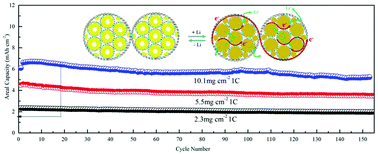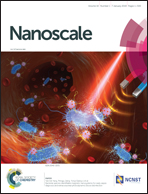Self-assembled N-graphene nanohollows enabling ultrahigh energy density cathode for Li–S batteries†
Abstract
Functional porous carbon materials are widely used to solve the low conductivity and shuttle effect of Li–S batteries; however, the common carbon/sulfur composite electrodes based on traditional technology (with conducting agents and binders) make it difficult for a battery to work stably at an ultra-high sulfur loading of 10 mg cm−2. Herein, an appropriate content of sulfur was injected into a pomegranate-like structure self-assembled with nanohollows (PSSN) of N-graphene. The Li-PSSN/S battery based on traditional technology displays a large-capacity, high-rate and long-life at an ultra-high areal-sulfur loading of 10.1 mg cm−2. The excellent performance with ultra-high areal-sulfur loading can be attributed to the hierarchal nanohollows with graphene-shells being in close contact to build a 3D-electronic conduction network and promoting electrolyte adsorption into the entire electrode to maintain rapid Li-ion transport, while stopping the shuttle-effect via the strong interaction of polysulfide with the doped N elements on graphene-shells. In addition, the exact sulfur content can provide just enough space to maintain the huge volume change and constant thickness of the S-electrodes during the charge–discharge process to enhance the cycling stability.

- This article is part of the themed collections: Graphene Turns 15: Bio-implications and Bio-applications and International Year of the Periodic Table : Low Dimensional Carbon Systems


 Please wait while we load your content...
Please wait while we load your content...